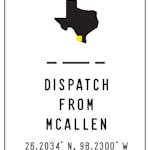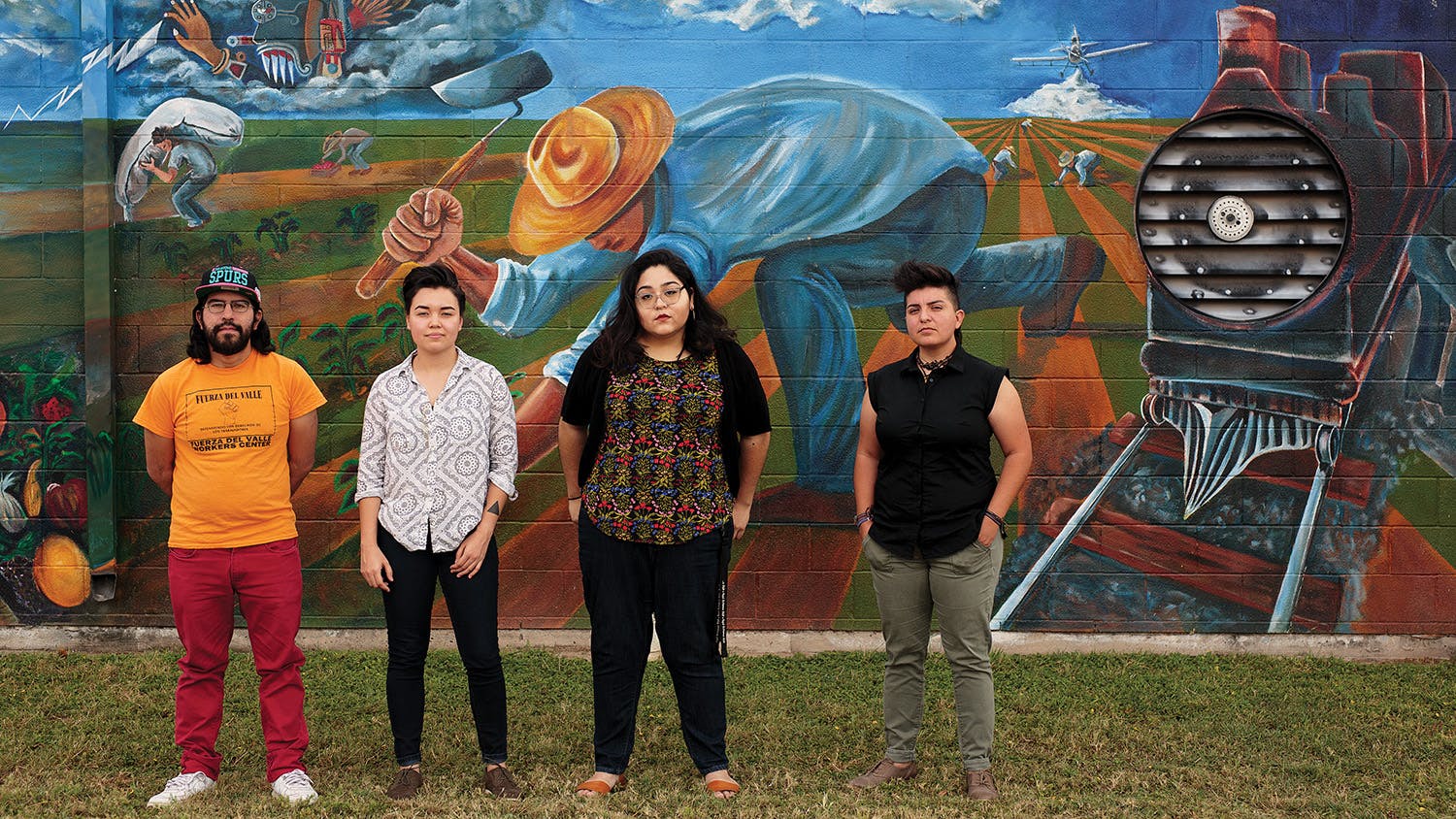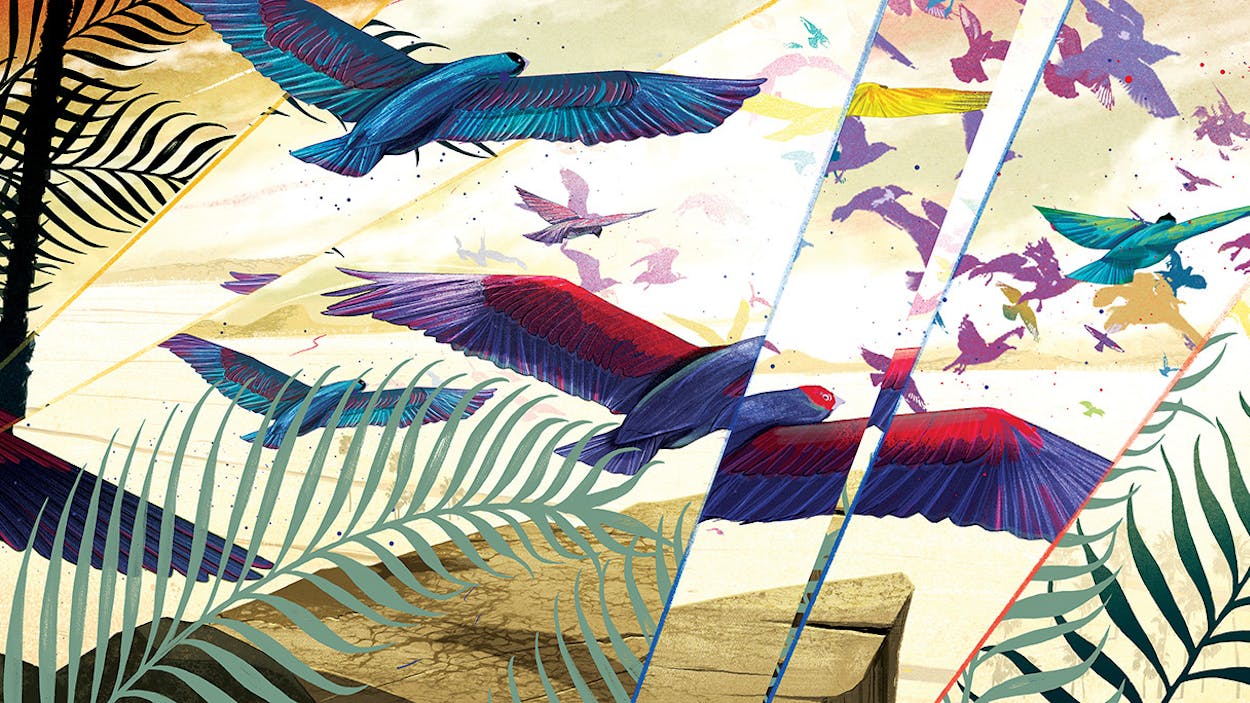 Two years ago, a 28-year-old Rio Grande Valley music journalist and DJ named Eduardo Martinez decided that he was too frustrated with a local TV station’s coverage of undocumented immigrants to keep quiet. “KRGV was always framing immigration in a very negative light and running stories about how harmful undocumented people were,” Eduardo told me. He and his friends—bilingual, bicultural millennials who had grown up in the Valley—took particular issue with the station’s continued use of the terms “illegals” and “illegal immigrants.” Some of them were themselves sin papeles, without papers. All of them had a relative, a co-worker, or a friend who was undocumented.
Two years ago, a 28-year-old Rio Grande Valley music journalist and DJ named Eduardo Martinez decided that he was too frustrated with a local TV station’s coverage of undocumented immigrants to keep quiet. “KRGV was always framing immigration in a very negative light and running stories about how harmful undocumented people were,” Eduardo told me. He and his friends—bilingual, bicultural millennials who had grown up in the Valley—took particular issue with the station’s continued use of the terms “illegals” and “illegal immigrants.” Some of them were themselves sin papeles, without papers. All of them had a relative, a co-worker, or a friend who was undocumented.
To Eduardo and this loose-knit coalition of activists, the phrase “illegal immigrant” was nothing less than a slur. In 2013 the Associated Press had set a new journalistic standard when its editors stopped sanctioning use of the phrase, reasoning that the word “illegal” should only be employed when describing an action, not a person. Frustrated by KRGV’s continued use of the outdated phrase, Eduardo and his friends took action. In April 2015 they kicked off a Twitter campaign with the hash-tag #KRGVBasta (“KRGV, enough”) and drafted a Change.org petition. “Humans cannot be illegal,” read a statement on the site. “In the Rio Grande Valley, our community is familiar and sensitive to the stories of immigrants . . . To many of us, these stories are also part of our own biographies. Many of us are those people . . . This language questions our humanity by calling us ‘illegals.’ ”
The Texas-Mexico border has always been a place of competing narratives—about exactly where the boundary between the two countries lies; about what living at the edge of two cultures means; and even about which language, and which words, should be used to tell its story. The campaign against KRGV would be the first, but not the last, time that Eduardo and his friends would try to shape the narrative. Within days of the protest’s launch, KRGV management invited them to the station to discuss their frustrations. News director Jenny Martinez assured the group that KRGV had already barred the use of the terms “illegals” and “illegal immigrant,” but she agreed not only to remind its reporters—some of whom were new and unaware of the rule—of the policy but also to enforce it. Eduardo felt that he and other members of the coalition had won a small but significant victory.

Not long afterward, the group began talking about another blind spot for local media: the gay and lesbian community. The experience of being LGBT in the Valley was, they felt, almost entirely ignored, and the representations they saw in popular culture bore little resemblance to their reality. “Being a gay person seemed to only mean being white, upper middle class, having expensive clothes, going to clubs,” Eduardo told me. “It didn’t mean listening to Tejano music and watching Cowboys games.” A friend of his, Erika Galindo, felt a similar disconnect. “On TV, everything looked like the The L Word and The Real L Word,’’ she said, referring to the long-running Showtime series and its reality-show spinoff. “All the lesbians were thin and rich and white, and they wore a lot of flannel. They lived in Los Angeles or New York, and maybe they’d adopted a kid or two. But that’s just not our reality. Adoption is too expensive for most queer women down here. Many of them already have children from previous relationships. And we don’t wear flannel. It’s too hot!”
Two months after the KRGV protest began, in the summer of 2015, Eduardo, Erika, and more than a dozen friends decided to start a youth-led LGBT group they called Aquí Estamos (“Here We Are”). The effort was spearheaded by then-twenty-year-old Daniella Marrero Hi, a Mission native who spoke of the “intersectionality” of issues like immigration with gay, lesbian, and transgender equality. Though Dani and her cohort had few financial resources—many of them still lived at home—they managed to organize the Valley’s first-ever LGBT conference. “None of us had cars and we lived all over the Valley,” said Eduardo, “so when we needed to meet up, we would borrow our parents’ cars or find rides or carpool or bike. If all else failed, we had Google Hangouts.” With a budget of next to nothing, they managed to put on a two-day conference that August in McAllen that drew more than two hundred attendees. The keynote speaker was Carlos Padilla, the national coordinator of the Queer Undocumented Immigrant Project, an advocacy group for LGBT people who lack legal status.
But shortly before the second Aquí Estamos conference was held, the following summer, the group was confronted with the limits of its ability to shape the narrative it wanted to tell. Another local TV station, KGBT, aired a story about how an Edinburg resident had been arrested for attempting to sexually assault a child. “The story went out of its way to highlight that the alleged perpetrator was transgender, which was not relevant,” Dani told me, adding that this seemed to be part of a pattern in which KGBT emphasized the sexual orientation of LGBT people who were accused of crimes. “So we issued a statement saying that we were not going to grant interviews to the station until its reporters received training in how to cover LGBT issues fairly.” This protest kick-started a larger conversation that resulted in a two-hour-long media training course, hosted by the local paper, the Monitor, last August. Reporters from nearly all the Valley’s major English- and Spanish-language news outlets attended. “We wanted them to understand how to report stories accurately, without causing harm,” Dani said.
But it became clear that month, when Donald Trump clinched the Republican nomination, that Eduardo, Erika, Dani, and their friends needed to think bigger when it came to media coverage. Trump had already denounced Mexican immigrants as “rapists” and criminals, pledged to carry out mass deportations, and promised to build a wall on the southern border. Then, last October, he vowed to purge the country of its “bad hombres.” For Eduardo, Erika, and Dani, his win in November brought their mission into focus. “Because of Trump’s rhetoric, reporters were coming here from all over the country before the election, and they wrote stories that would lead with a statistic about how poor the Valley is, or about how it’s the Wild West,” Erika said. “After the election, we knew there were going to be a lot more eyes on the Valley. We knew that if we didn’t tell these stories ourselves and take ownership of them, then other people would come and speak for us. And we didn’t want someone to take our reality and twist it for political purposes.”
Dani noticed in the wake of the election that many of her friends were starting their own YouTube accounts and WordPress blogs. “I thought, ‘What if we did it all together, on one platform?’ ” she told me. “I could still write about LGBT issues, Erika could still write about immigration, Eddie could write about music and culture, and we could get all of our friends to contribute. Eddie and Erika and I had already kicked around the idea of starting a magazine that was about radical politics, so it wasn’t a new concept to us. When I brought the idea up with them, they were like, ‘Let’s do it.’ ”
Their new media venture, which launched this past January, is called Neta—Spanish slang that loosely means “legit,” “no BS,” “the truth.” (As Dani explained, “If a friend of yours said, ‘Donald Trump just got impeached!’ Then you’d be like, ‘¿Neta? For real?’ And your friend might say, ‘¡Neta! ’ ”) The name is a nod to the young, culturally specific, linguistically fluid audience that the bilingual site serves, as well as an acknowledgment of its commitment to producing reliable, fact-based journalism in an era of fake news. The goal of Neta, according to its mission statement on the site, is to amplify “the voices of border residents” and “challenge mainstream narratives about our region.”
Trying to counter the overheated, nativist language that has gripped the country these days is not easy; the prevailing story line out of the White House, Fox News, and the alt-right casts the border as a place overrun with violent criminals, drug traffickers, gang members, and Mexican and Central American freeloaders who proudly flout federal immigration laws with impunity. Dani herself did not realize how entrenched those ideas were until she went to Los Angeles last year and struck up a conversation with an older couple, who were stunned to learn where she lived. “I could see the concern on their faces,” she told me. “I was shocked by how worried they were about my personal safety. I told them, ‘Actually, we have lower-than-average crime rates on the border. El Paso is one of the safest cities in the country. And in McAllen, we had two homicides last year. We’re pretty boring.’ I remember them looking at me like they didn’t really believe me, like they thought I must be uninformed.”
That is not to say that Neta’s founders are boosters for the Valley who ignore its many challenges. They plainly see the many obstacles the region faces, from endemic poverty to a vast digital divide. But rather than scapegoat the people who live there, they are interested in examining the systemic forces at work. “I know that poverty didn’t just happen,” Erika said. “I want to look and see how that actually came to be. I know that agricultural workers in the Valley were kept in debt for generations by the people who owned this land.” Part of Neta’s responsibility, she explained, is to get its readers to think more deeply. “A lot of people talk about how it’s so cheap to live in the Valley and how we have this super-affordable cost of living, but that’s because wages are so low,” she said. “These things are corollary. I want to look at that: Why has the Valley stayed so poor? And what do people who are actually living here, in poverty, have to say about it?”
Though its purpose is serious, Neta is not dry or academic; it’s a quick, smart, and often funny read, and thanks to Dani’s formidable skills as a web developer, it has a sophisticated design. On any given day, the site—netargv.com—is a mash-up of the political and the personal, with articles and videos by sixteen contributors. A serious-minded article about how proposed federal budget cuts may affect low-income Valley residents is just a click away from a clever, tongue-in-cheek video explaining the meanings of ten Spanglish phrases that are popular in the Valley. (“When my prima gets a new pair of shoes, I’m like, ‘No pos wow.’ ”) The site is full of thought-provoking, and divergent, subjects: Brownsville’s cycling culture; a McAllen endocrinologist who works with transgender patients; an app for people targeted by immigration raids; the 1971 Pharr Riots, the watershed moment in the Valley’s civil rights struggle; and the state’s accordion championship finals.
Though Neta is a labor of love, the hope is that it will become self-sustaining. “We want to get to the point where we have a little studio, and some equipment, and we can be compensated for our work, but right now, we’re happy if we just have enough to keep going,” Dani told me. Ideally, in the future, Neta will be partially funded by subscriptions, as well as through partnerships with foundations and private donors, though fund-raising for the site is still in its nascent stages. Still, there are big plans ahead: a podcast, a print edition, and a collaborative relationship with its readers. “We hope that by this time next year, we’ll have enough subscribers that we could have a town hall with them every few months and they can tell us what they liked and didn’t like,” she said.
What I liked the most, I told her, was an arresting series of images I had seen on Neta by a documentary photographer named Verónica Cárdenas. With the assistance of Catholic Charities of the Rio Grande Valley, Vero (who, like all of Neta’s contributors, is largely self-taught) had managed to procure 433 pairs of shoes that immigrants had worn on their journeys north to the U.S. Then she had photographed each pair: an eight-year-old Honduran boy’s raggedy high tops; a seven-year-old Salvadorian girl’s black running shoes; a four-year-old Guatemalan boy’s small, blue sneakers. Absent their owners, these still lifes were haunting. But Vero had not stopped there; she had gone on to arrange all 433 pairs of shoes, en masse, at locations that their owners had likely traversed—beginning on a bluff by the Rio Grande, where they had first stepped out of the water and onto dry land, and ending where they had found refuge, at Sacred Heart Catholic Church in McAllen.
The images were surreal, shocking, heartbreaking—and they told a story so true, and so moving, that they made the hysteria of our current political climate recede, until all that was left was the raw humanity of those who had dared to cross the border. This, I understood, was neta.







